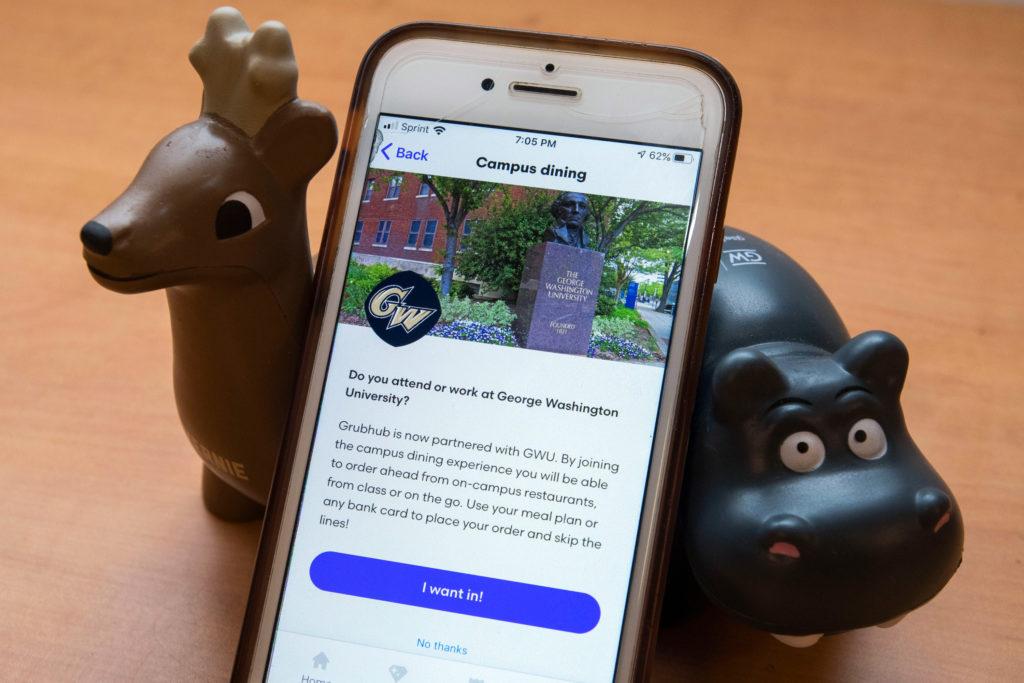Editor’s Note:
This story has been updated to include clarifications from GW Dining. The post has been updated to include information about promotion of dining programs, delivery costs and use of the GET app to place orders.
Updated: Oct. 8, 2020 at 5:11 p.m.
When junior Diing Manyang tested positive for COVID-19 in early July, she depended on the University’s food delivery service to scrape together meals while she was isolated in South Hall.
After ordering delivery straight to South Hall four times when she was sick and more than 10 times when she was living on campus during the summer, Manyang realized she was paying upward of $30 for most meals and could no longer afford the service. Since the fall semester began, she’s only ordered delivery twice because she considers the service too expensive.
The University partnered with Grubhub this summer to offer students a free Grubhub+ membership for a year with each student who links their account with GW. But students living on campus this fall said despite the convenience of the service, officials have mischaracterized the costs of buying food through the program, restricting them from ordering meals cheaper than $20 through the GET app and attaching pricey delivery fees.
“If I had an option, I would have been doing delivery, but it’s too expensive,” Manyang said. “So I have to go in person to buy whatever I need.”
University spokesperson Crystal Nosal said officials organized delivery programs through partnerships with Grubhub, Whole Foods and Healthy Fresh Meals to offer students safe dining access when they’re isolated on campus.
“With safety as a top priority, the University communicated with all GWorld merchants our expectation that they adhere to the CDC, D.C. and GW guidelines guiding the University’s COVID-19 response,” Nosal said in an email. “We are grateful to work with food delivery partners who have also introduced smart COVID-era safety policies, like contactless delivery and enhanced sanitation.”
GW added Healthy Fresh Meals, which delivers precooked meals, to its selection of GWorld vendors two years ago before starting delivery partnerships with Grubhub and Whole Foods this summer.
The Healthy Fresh delivery option allows students to use their GWorld to meal prep with “bulk family style proteins” and sides without a subscription to the company’s service, according to GW Dining’s website. The Whole Foods delivery service lets students fill out an online order form before deciding to pick up groceries or get delivery free of charge, the website states.
Each delivery service manages its own COVID-19 health and safety protocol with sanitation, personal protective equipment requirements and contact-free handoffs to prevent the spread of the coronavirus, Nosal said.
She added that officials who are updating students about GWorld delivery services during the pandemic are “pleased” with the reception from students on campus.
She said students’ Grubhub+ memberships through the GW partnership receive free delivery on “many orders,” while some locations still charge delivery fees. She said any delivery fee on the GET app is vendor-imposed.
Junior Christian Zidouemba, who lives in South Hall and studies international business and international affairs, said he wasn’t previously familiar with the Whole Foods and Healthy Fresh delivery options but ordered nine meals from Grubhub last month.
He said Grubhub would add a $10 delivery fee for most orders, and if he wanted to use the app to purchase two meals in one day, he would often be paying $60. Zidouemba said he’s since stopped ordering Grubhub delivery because the attached fees were too expensive.
Zidouemba said officials should better communicate the new delivery programs so more students on campus would be inclined to use them. He said site coordinators who have maintained close contact with students living on campus this fall should send information about the delivery programs to the residents they supervise.
“That would be the best way because they’ve been doing a lot of reaching out to students so I think they would be best fitted to do that job,” he said.
Officials said in addition to Campus Living & Residential Education staff members sharing the information with students, TV monitors display delivery options to students.
Although the University’s website promotes the Grubhub program as offering contact-free delivery, keeping six feet apart from delivery drivers is more complicated than advertised, Zidouemba said. Since drivers don’t have access to residence halls, the only spot to drop off meals is outside the front door, where Zidouemba said someone once almost stole his meal moments before he stepped outside.
To ensure he receives each meal he pays for, he said he has to walk outside and physically grab his food from the driver.
“When they come, they cannot enter the building, so someone has to leave it out,” he said. “You have to go out and get it if you want your food.”
Officials said those without a GWorld card are not allowed in GW buildings, and students can track their food on delivery apps.
Zidouemba said he’s resorted to purchasing food in person from Whole Foods and local restaurants, where he feels comfortable during the pandemic as long as everyone wears PPE and keeps safe distance from each other.
Sophomore Emily Mosley, who transferred to GW this fall and studies international affairs, said she picks up groceries every week from Whole Foods, allowing her to meal prep without shopping through the entire store. Mosley said she can grab her groceries in a few minutes near the checkout area, which is sanitized.
“I’m able to just cook in my dorm in District House, and so that’s eliminated me being around a lot of people to pick stuff up or just be inside shopping,” she said. “I think that’s been extremely helpful.”
Since she can stock up supplies from Whole Foods, Mosley said she avoids ordering from Grubhub more than once a week, where she often pays $6 in delivery fees for each meal. Mosley said loading her GWorld card onto the delivery app makes payments simple, but she hasn’t noticed any discount despite GW’s claims stating that delivery would be free.
“I haven’t noticed any massive discount or anything that I’m saving, and especially when delivery is something like $6, you don’t get a ton of savings off of Grubhub-ing one meal,” she said.










